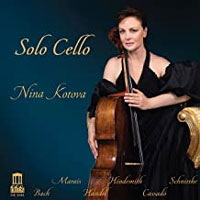Nina Kotova • Solo Cello Delos DE3588
For her third recording on the Delos label, Kotova has chosen familiar and not-so-familiar compositions for unaccompanied cello. While any of these selections can stand on its own merit, it’s best to imagine you’re attending a recital and listen to this recording from the beginning to fully appreciate Kotova’s inventive programming and the intimate recording quality Delos delivers. The program begins with an arrangement of Couplets des Folies d’Espagne based on Marin Marais’s Suite in D minor for viola da gamba. Today, Marais is not widely known outside music-history textbooks, but he was a student of Jean-Baptiste Lully and was employed in the court of Louis XIV. Kotova and Christian Dobereiner co-arranged this piece for modern cello. The term “Folies d’ Espagne” came from the Iberian Folia, a vigorous dance from Portugal, but by Marias’s time, the Folias had become less dancelike and more of a thematic basis for compositions. Although written in the Baroque, the use of a Renaissance melody and harmonic structure strongly suggest these are early dance tunes, as does Kotova’s emphasis on rhythmic pulse. Hindemith’s Sonata for Solo Cello, with its ambiguous tonality and angular melodic lines, sounds quite otherworldly after the Marais. Kotava’s aggressive playing and technique prove to be a good match for this 20th-century masterwork for solo cello. Schnittke’s Klingende Buchstaben, written in honor of the 40th birthday of cellist Alexander Ivashkin, is a perfect companion piece, sounding almost like a coda to the Hindemith. Kotova’s delivery of the sliding melodic lines is sorrowful, and the high harmonics at the end give an eerie whistling finish. Following the austere sounds of Hindemith and Schnittke is a lovely interpretation of Bach’s famous Suite No.3 in C major for solo cello. Although filled with plenty of energy, Kotova’s approach feels relaxed, with the Allemande and Courante movements having a touch of playfulness. Coupled to the Bach is a transcription from Handel’s harpsichord Suite No.7. This is a challenging arrangement incorporating rapid scale passages and a variety of bowing and pizzicato sections, including ricochet bowing and left-hand pizzicato plus arco, which allows a single player to sound like two musicians playing at once. Kotova easily handles the technical challenges this arrangement presents. The final selection is by a composer new to me, but better known in the cellist world. Gaspar Cassadó was a composition student of both Manuel de Falla and Maurice Ravel and studied cello with Pablo Casals. His Suite for Violoncello Solo is definitely modern, but it uses Spanish dance melodies and, as such, sounds more “popular” in nature than the more academic compositions of Hindemith and Schnittke. Veteran recording engineer Tom Lazarus captures Kotova’s warm cello sound and its powerful low register in a lively acoustic. Recorded in Italy at The Museo del Tulle, a former church with plaster walls and a high, wooden ceiling, yielded a generous and pleasant reverberation halo to the recording. The only distraction is when the music utilizes multiple double stops in the cello’s lowest register, the chords tend to stack on top of each other, somewhat muddying the recording. Using my Stax headphones alleviated much of the issue. There are many reasons to like this recording. Nina
Kotova has a beautiful, dark tone and impeccable technique. The choice of music is
excellent as is its programming, keeping the listener engaged and challenged. Solo
Cello is intelligent and exciting music-making. |

 ussian-born
cellist Nina Kotova began her professional career performing at Wigmore Hall in
London’s Barbican Centre. Following that success, she signed with Philips, releasing
her first commercial recording in 1999. Kotova has also recorded for Sony, Deutsche
Grammophon, Warner Classics and Delos. Besides her performance career, she has modeled for
fashion designers, collaborated with artists on music and environmental projects, and has
been on the music faculty of the University of Texas-Austin. Kotova is presently Professor
of Cello at the International Academy of Imola in Italy.
ussian-born
cellist Nina Kotova began her professional career performing at Wigmore Hall in
London’s Barbican Centre. Following that success, she signed with Philips, releasing
her first commercial recording in 1999. Kotova has also recorded for Sony, Deutsche
Grammophon, Warner Classics and Delos. Besides her performance career, she has modeled for
fashion designers, collaborated with artists on music and environmental projects, and has
been on the music faculty of the University of Texas-Austin. Kotova is presently Professor
of Cello at the International Academy of Imola in Italy.